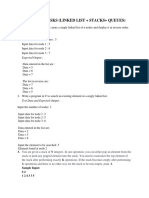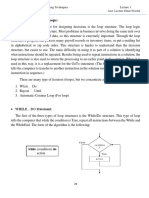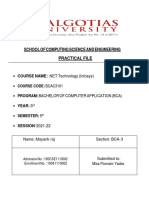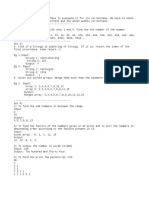C#-VisualProgramming-Lab 1
Uploaded by
gado zanganaC#-VisualProgramming-Lab 1
Uploaded by
gado zanganaPrepared By: Snwr Jamal C# Practical
Network Department
Lab 1
Exercise 1: Write a code that creates the following pattern:
**********
**********
**********
**********
**********
Exercise 2: Write a code that gives you the following pattern:
1
12
123
1234
12345
123456
1234567
Then, let the user specifies the number of rows.
Exercise 3: Write a code that generates the following pattern:
1234567
123456
12345
1234
123
12
1
Then, let the user specifies the number of rows.
Exercise 4: Write a code that calculates the sum of maximum 6 numbers. The program
will be stopped when you enter even number.
Exercise 5: Write a code that calculates the sum of maximum 5 numbers. The program
will skip the positive numbers from the calculation.
Exercise 6: Write a code that enters 10 numbers then calculates the number of positive,
negative and zero elements.
You might also like
- Practice Tasks (Linked List + Stacks+ Queues)No ratings yetPractice Tasks (Linked List + Stacks+ Queues)5 pages
- Java Programming Syllabus Assignment LabPracticeNo ratings yetJava Programming Syllabus Assignment LabPractice14 pages
- JavaScript_Syllabus_Assignment_LabPracticeNo ratings yetJavaScript_Syllabus_Assignment_LabPractice13 pages
- Equiv Ta Decimal Number To Binary NumberNo ratings yetEquiv Ta Decimal Number To Binary Number14 pages
- ملخص لغات تالته تيرم اول.pdf · إصدار _١_ (1)No ratings yetملخص لغات تالته تيرم اول.pdf · إصدار _١_ (1)11 pages
- Problems Solving With Loops:: WHILE DO StatementNo ratings yetProblems Solving With Loops:: WHILE DO Statement11 pages
- Loops: Execute Blocks of Code Multiple TimesNo ratings yetLoops: Execute Blocks of Code Multiple Times62 pages
- Swift and C# Quick Reference - Language Equivalents and Code ExamplesNo ratings yetSwift and C# Quick Reference - Language Equivalents and Code Examples1 page
- Tutorial Sheet 1-Introduction To Algorithm-Software EngineeringNo ratings yetTutorial Sheet 1-Introduction To Algorithm-Software Engineering9 pages
- Microsoft - Test Papers.98 361.v2014!06!10.by - JesusNo ratings yetMicrosoft - Test Papers.98 361.v2014!06!10.by - Jesus38 pages



























































